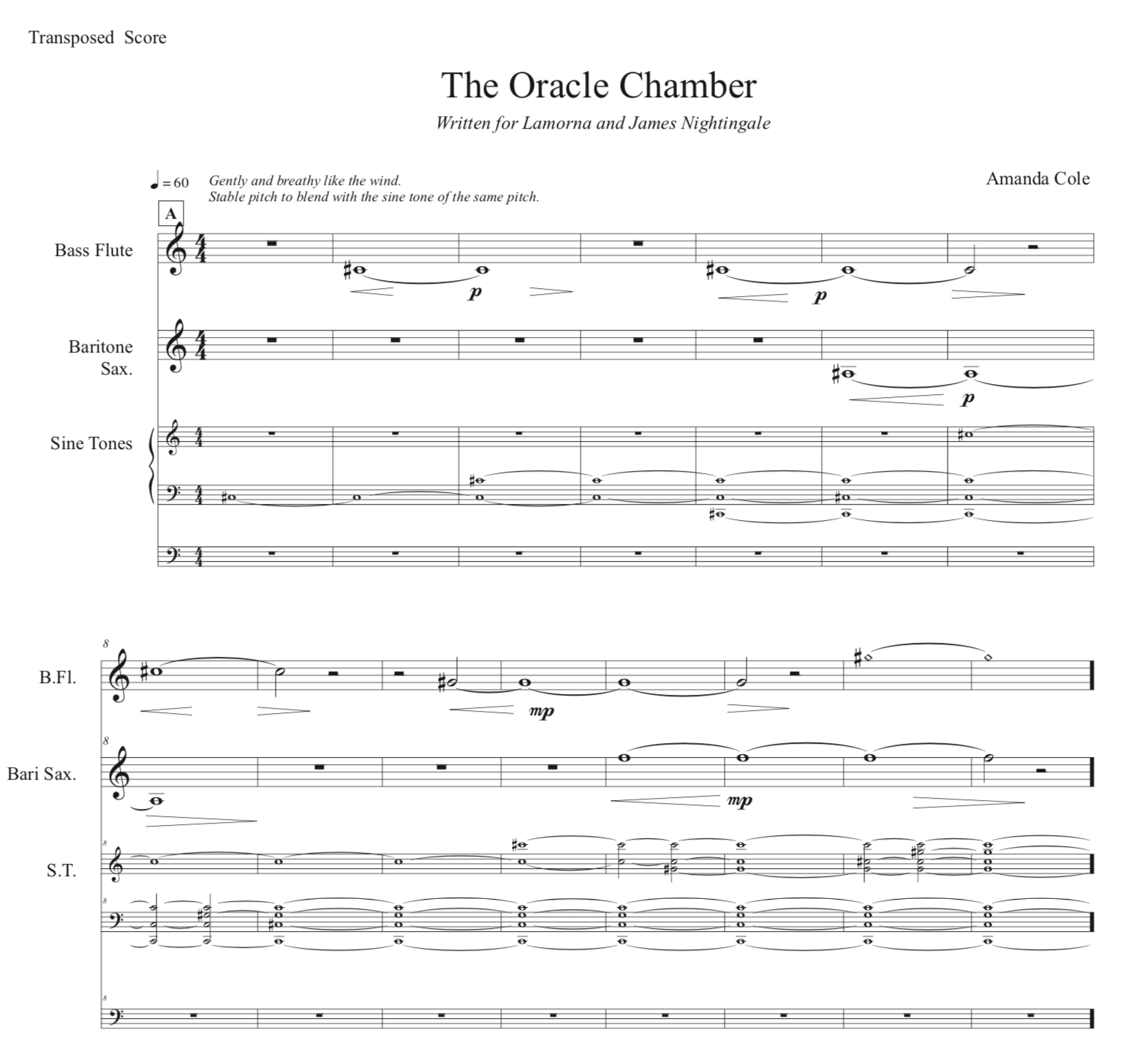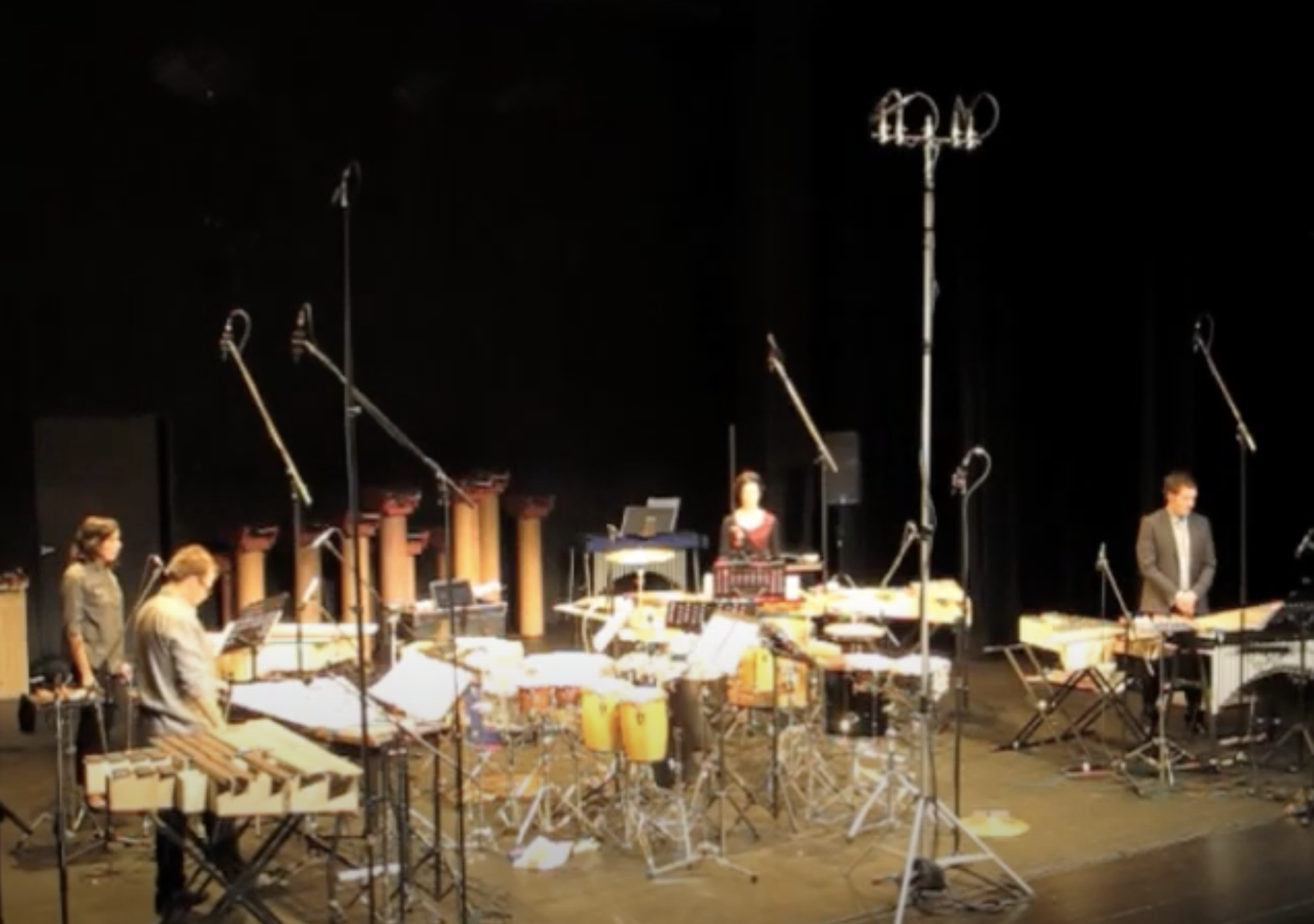This page contains information and program notes about my scored music for acoustic instruments. All pieces incorporate microtonal pitches either through an electronic music part or by playing microtonal notes on instruments such as cowbells or woodwind instruments. Some of my scores can be purchased through The Australian Music Centre. If you are interested in a score that you can not locate please email me. If you would like to commission a new instrumental concert piece please get in contact to discuss your idea or project. .
PASSION CHORALE (2021)
For SATB Choir
Passion Chorale is a microtonal arrangement of Bach’s Passion melody using just intonation tuning. Vowels are used to change the timbre of notes and to bring out different vocal overtones. Scored for SATB choir, the singers pitch the microtonal notes by listening to a reference track. The notes of the Passion melody are tuned to either the C or G harmonic series and the G from both series is held as a drone throughout.
The scrolling score made by the N.E.O. voice festival that I sing one of the alto parts can be heard here: https://www.youtube.com/watch?v=WuFAe6d5GXg
Singing in Tune With Nature (2020)
For SATB Choir
Singing in Tune with Nature' is my brand new SATB choir piece written for this year’s N.E.O. Voice Festival. Written in a 14-note-to-the-octave just intonation scale exploring vocal overtones, this piece might sound like throat singing. To sing this piece each vocalist listens to an audio track with reference tones for each note they sing. The program note is below:
‘Singing in Tune with Nature’ aims to draw attention to the beauty and possibilities of singing overtones that are natural to the human voice. Using just intonation tuning, each sung interval comes from the harmonic series rather than the twelve notes found on the piano. The singing techniques and microtonal tuning used are a metaphor for appreciating and focusing in on our natural environment.
The scrolling score made by the N.E.O. voice festival that I sing one of the alto parts can be heard here:https://www.youtube.com/watch?v=jUIEXv3RFQU
Please email me if you are interested in this work.
Singing in Tune with Nature Score excerpt.
THE ORACLE CHAMBER (2020)
For Bass Flute, Baritone Saxophone and Sine Tone Interference Beats.
This duet for low woodwind instruments and sine tones conjures up the eerie resonant tones that might have echoed throughout The Hypogeum of Hal Saflieni in Malta 5000 years ago in what is believed to be the oldest prehistoric underground temple in the world. Within this subterranean structure is a unique space called ‘The Oracle Chamber’, which is carved out of solid limestone and has incredible acoustic properties. When particular low notes including the low C# played in this piece are sounded, they resonate throughout the entire structure.
This piece was commissioned and given its premiere performance by James and Lamorna Nightingale. Their Phoenix Central ‘Behind Doors’ performance can be seen in this video at 12:44. https://www.youtube.com/watch?v=VHC80EQ4TGk
Please email me if you are interested in this work.
James and Lamorna Nightingale premiering ‘The Oracle Chamber’ at Phoenix Central in Sydney, 2020
VIBRAPHONE THeORIES (2007)
Vibraphone Theories is a set of three rhythmic pieces for vibraphone and sine tones interference beats. The sine tones are played as a stereo electronic music part during a live performance. Microtonal intervals in the sine tone part create amplitude beats, which have been sequenced to create the rhythms notated in the score. When the vibraphone plays notes close in pitch to notes in the sine tone part, additional beating is created. The similar timbres of the vibraphone and sine tones are blended together to sound like one instrument, where the interference beats sound similar to vibrato.
Vibraphone Theories was performed by Kroumata in Sweden for the 2009 International Society of Contemporary Music (ISCM) festival. This piece was also recorded by Portuguese percussionist Nuno Aroso for his CD Technicolor. It has since been performed in New York by Sean Statser in an ExhAust concert titled 'Sine & Syrinx' (2013) and by Daniel Pate in the New York City Electroacoustic Music Festival (2016).
See Melbourne based percussionist Louise Devonish play Vibraphone Theory 1 in a recent recorded concert here: https://www.facebook.com/MonashUniversitySchoolofMusic/videos/539322356738972/
or on VIMEO at: https://vimeo.com/421306228 (23’24”)
The score and audio parts for the performance of this piece can be purchased from the Australian Music Centre and Cut Common Music. https://www.australianmusiccentre.com.au/workversion/cole-amanda-vibraphone-theories/26209
First page of Vibraphone Theory 2. The rhythms of the sine tone interference beats are notated in the score.
Lousie Devonish performing ‘Vibraphone Theory 1’ at Monash University, 2020.
GLOCKEN BLOCKEN
Glocken Blocken is a rhythmic and energetic percussion solo that combines Marimba and Almglocken (cowbells). Similar phrases are played on the Marimba and cowbells, highlighting the differences in pitch and timbre between the instruments. The cowbells are slightly out of tune, which creates a microtonal variation of the same material played on the marimba.
Glocken Blocken was premiered by percussionist Claire Edwardes at the Sydney Conservatorium in an Ensemble Offspring concert. It has since been recorded by Claire at the ABC recording studios and has been released on her CD 'Kammerbox'. Early this year Claire’s recording of Glocken Blocken was included on the ABC Classics album Women of Note https://www.abc.net.au/classic/featured-music/feature-albums/women-of-note-2/12003412
This score can now be purchased as a digital download from The Australian Music Centre : https://www.australianmusiccentre.com.au/product/glocken-blocken-for-solo-marimba-and-almglocken-escore
Marimba and Cowbells set up for Claire Edwardes' performance of Glocken Blocken' at the National Portrait Gallery, Canberra, 2017.
LOOM PATTERNS (2018)
Looms Patterns is a contemporary piece for portative organ and an electronic music part made from sequenced sine tone interference beats. The piece has a rhythmic grid of 12 pulses per bar, which acts as a loom for the rhythmic and melodic patterns to be woven through. The electronic music part uses the same pitches played in the organ part and extends the limited range of the instrument. The precisely tuned electronic music part contrasts the unstable pitch and tone of the portative organ and at times may create additional interference beats between the live and electronic music parts.
Loom Patterns was premiered at the Art Gallery of NSW by Bree Van Reyk in the 'Music in This Stillness' concert in the Art After Hours concert series. All pieces in the concert were associated with or inspired by the famous French 'Lady and the Unicorn' tapestries displayed at the time at the AGNSW. Loom Patterns was commissioned by the AGNSW.
Email me if you are interested in obtaining a score for this piece or commissioning a new piece for sine tones and live instruments.
Bree Van Reyk playing Loom Patterns for organetto and sine tones by Amanda Cole, Art Gallery of NSW - May 9, 2018
Score excerpt of Loom Patterns by Amanda Cole for organetto and sine tones.
Screen shot from Logic software showing sequenced sine tone interference beats for the Loom Patterns sine tone part.
NODE
Node is a flute solo written for Janet Mckay that is a study in using enharmonic fingerings to play specific microtonal pitches that can be found as natural harmonics on the C and G strings of a cello. Each harmonic overtone has an evenly spaced node along a string. When a natural harmonic glissando is played a sequence of natural harmonics are heard. The melodic material in the piece is made from fragments of adjacent linear clusters of natural harmonics that are found on the C and G cello strings. These separate pitch rows or “strings” of frequency values are used as separate motifs that are developed and manipulated to create the two movements of the work.
This score can be purchased from Cut Common as a digital download.
Score Excerpt - Node : Microtonal Flute Solo by Amanda Cole
INTERMETALLIC (2012)
For Percussion Quartet (tuned percussion and Sixxens) with an Electronic Music Track of Sine Tone Interference Beats.
Intermetallics are compounds that form when certain combinations of two or more metals are mixed together in certain proportions and react to produce a solid phase that is distinctively different from the constituent elements. In Intermetallic, a range of metallic timbres are combined to create new hybrid timbres. Notes close in pitch are heard by the ear as fused tones with various speeds of pulsating interference beats. This composition has been composed for the Sixxen paired with 12 tone equal tempered notes of the vibraphone and crotales to create interference beats. The exploration of interference beats in this piece was influenced by Indonesian Gamelan music and the beating inharmonic partials of a Tibetan bowl being struck. The electronic music part is used to create beating in octaves lower than the tuned percussion notes.
Other microtonal metallic pitched instruments could be substituted for the Sixxens.
Synergy’s 2012 premiere of this piece can be seen in this video: https://www.youtube.com/watch?v=OmmW0hHHMAg
Please email me if you are interested in the score.
Synergy Percussion premiering Intermetallic at Casula Powerhouse in 2012
MELATONIN (2014)
Melatonin is a short experimental excerpt of music created from the colours and design of the painting ‘Melatonin Shift #3’ (from the series Time—Feeling Time 2003–06) by Australian artist Robert Owen. In this sonification of Owen’s painting, it is used as a score that is read from left to right, from top to the bottom of each vertical column. The colour blocks in the painting were analysed as RGB numbers by Amanda’s sister Jayne Blake, which were then mapped to microtonal frequencies. The RGB value of each square or rectangle is used to divide an octave (which contains 1200 cents). The duration of each note in the music composition is set by the length in units of each colour block. A range of synthesised sounds were used to realise this composition. Interference beats can be heard when notes close in pitch or colours close in hue are played at the same time. Some of the columns were layered in the music composition to create a thicker texture. Interference beats can be heard when notes close in pitch or colours close in hue are played at the same time
Melatonin Shift #3 (from the series Time—Feeling Time 2003–06)













